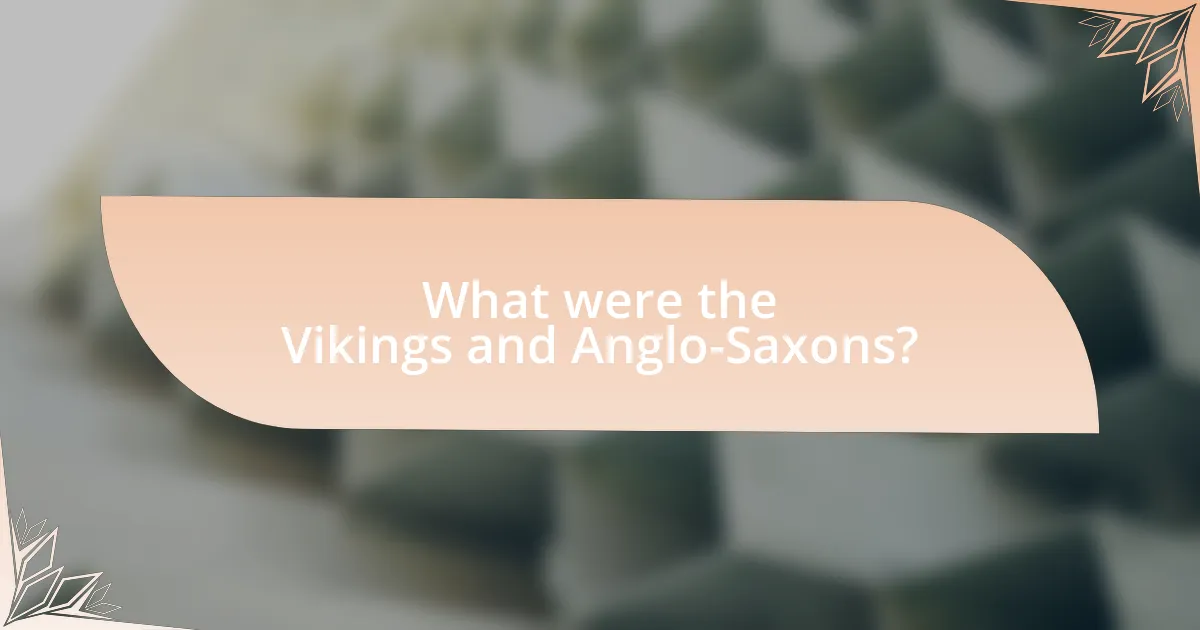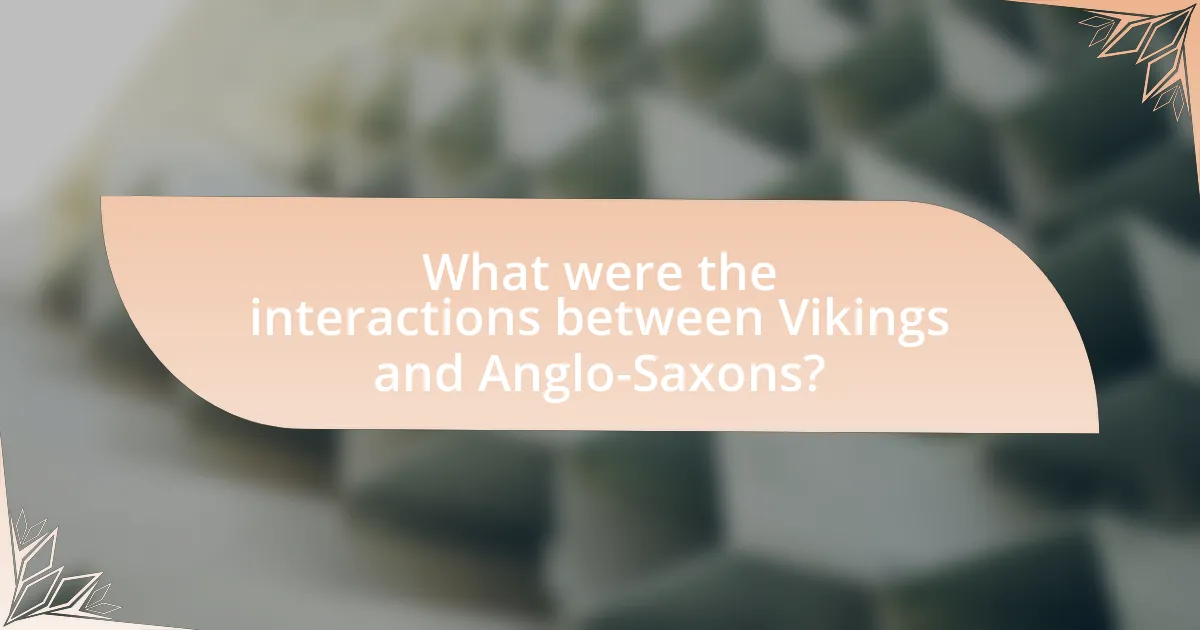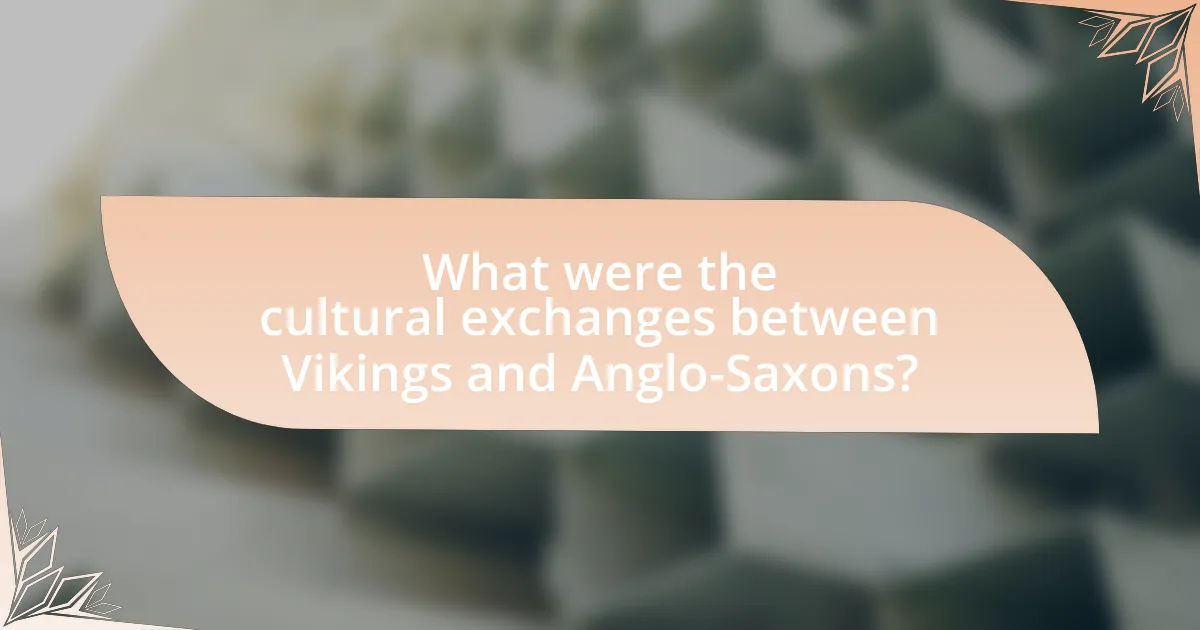The article examines the historical interactions between the Vikings and Anglo-Saxons, two significant groups in early medieval Europe. It outlines the origins, societal structures, and geographical regions of both the Vikings, seafaring Norse people from Scandinavia, and the Anglo-Saxons, Germanic tribes that settled in England. Key themes include the nature of their conflicts, trade relationships, cultural exchanges, and the impact of religion on their interactions. The article also highlights pivotal events such as the Viking raids, the establishment of Danelaw, and the influence of these interactions on language, art, and societal development in England.

What were the Vikings and Anglo-Saxons?
The Vikings were seafaring Norse people from Scandinavia, known for their exploration, trade, and raids across Europe from the late 8th to early 11th centuries. The Anglo-Saxons were a group of Germanic tribes that settled in England from the 5th century, forming several kingdoms and significantly influencing the culture and language of the region. The interaction between these two groups was marked by conflict, trade, and cultural exchange, particularly during the Viking Age, when the Vikings invaded and settled in parts of England, leading to significant historical developments such as the establishment of Danelaw, a region under Viking control.
How did the Vikings and Anglo-Saxons originate?
The Vikings originated from the Scandinavian regions, primarily modern-day Norway, Sweden, and Denmark, during the late 8th century, characterized by their seafaring and raiding activities. The Anglo-Saxons, on the other hand, emerged from the migration of Germanic tribes, specifically the Angles, Saxons, and Jutes, to Britain in the 5th century following the decline of Roman rule. The Vikings are known for their exploration and settlement across Europe, while the Anglo-Saxons established several kingdoms in England, significantly influencing the culture and language of the region. Historical records, such as the Anglo-Saxon Chronicle, document these migrations and interactions, providing evidence of their origins and subsequent developments.
What were the key characteristics of Viking society?
Viking society was characterized by a strong warrior culture, a complex social hierarchy, and a rich tradition of seafaring and exploration. The warrior culture was evident in their raids and conquests across Europe, which were driven by both economic motives and the pursuit of glory. The social hierarchy included distinct classes such as nobles, freemen, and thralls (slaves), which structured their communities and dictated social roles. Additionally, their advanced shipbuilding techniques enabled long-distance travel and trade, facilitating interactions with various cultures, including the Anglo-Saxons. Historical records, such as the sagas and archaeological findings, support these characteristics, illustrating the Vikings’ influence and integration into the societies they encountered.
What defined Anglo-Saxon culture and society?
Anglo-Saxon culture and society were defined by a combination of Germanic traditions, a hierarchical social structure, and a strong emphasis on kinship and loyalty. The Anglo-Saxons, who settled in England from the 5th century, brought with them customs such as oral storytelling, pagan beliefs, and warrior ethos, which were later influenced by Christianity. The social structure was characterized by a king at the top, followed by nobles, freemen, and serfs, reflecting a feudal system that emphasized land ownership and loyalty to the lord. Additionally, the importance of community and kinship ties was evident in their legal systems and social interactions, as seen in the practice of wergild, a system of compensation for wrongs. These elements collectively shaped the identity and daily life of Anglo-Saxon society.
What were the geographical regions of the Vikings and Anglo-Saxons?
The geographical regions of the Vikings primarily included Scandinavia, which encompasses modern-day Norway, Sweden, and Denmark, as well as parts of the British Isles, Iceland, Greenland, and areas of North America such as Newfoundland. The Anglo-Saxons, on the other hand, inhabited what is now England, having settled in various kingdoms such as Wessex, Mercia, Northumbria, and East Anglia. Historical records indicate that Viking raids and settlements significantly impacted Anglo-Saxon territories, particularly during the late 8th to early 11th centuries, leading to cultural exchanges and conflicts between these two groups.
How did geography influence Viking expansion?
Geography significantly influenced Viking expansion by providing access to navigable waterways and coastal routes. The Scandinavian landscape, characterized by fjords and numerous islands, facilitated the development of advanced shipbuilding techniques, enabling Vikings to travel and raid across vast distances. Historical evidence shows that their longships were designed for both deep ocean and shallow river navigation, allowing them to penetrate inland via rivers like the Seine and the Thames, which were crucial for reaching key settlements in Europe. This geographical advantage, combined with their knowledge of wind patterns and tides, allowed Vikings to establish trade routes and settlements from North America to the Mediterranean, demonstrating the direct impact of geography on their expansionist endeavors.
What territories did the Anglo-Saxons inhabit?
The Anglo-Saxons inhabited territories that primarily included what is now England. This region was divided into several kingdoms such as Wessex, Mercia, Northumbria, and East Anglia during the early medieval period. Historical records indicate that the Anglo-Saxons migrated to these areas from the 5th century onwards, establishing their dominance over the native Celtic populations. The presence of archaeological sites, such as those in Sutton Hoo and the Anglo-Saxon burial mounds, further confirms their settlement and cultural influence in these territories.

What were the interactions between Vikings and Anglo-Saxons?
The interactions between Vikings and Anglo-Saxons primarily involved conflict, trade, and cultural exchange. Vikings, originating from Scandinavia, invaded and settled in parts of England from the late 8th century onwards, leading to numerous battles such as the Battle of Edington in 878, where King Alfred the Great of Wessex defeated the Viking leader Guthrum. This conflict resulted in the establishment of the Danelaw, a region in England under Viking control, which facilitated trade and cultural interactions between the two groups. Additionally, the Vikings influenced Anglo-Saxon society through the introduction of new technologies, art, and language, while the Anglo-Saxons adopted some Viking customs and practices. Historical records, such as the Anglo-Saxon Chronicle, document these interactions, highlighting both the violent confrontations and the eventual integration of Viking settlers into Anglo-Saxon communities.
How did the Vikings first come into contact with the Anglo-Saxons?
The Vikings first came into contact with the Anglo-Saxons through raids along the British coastline, beginning in the late 8th century. The most notable early encounter occurred in 793 AD when the Vikings attacked the monastery at Lindisfarne, marking the start of a series of incursions into Anglo-Saxon territories. This event is documented in the Anglo-Saxon Chronicle, which describes the devastation caused by the Viking raid, highlighting the shock and fear it instilled in the Anglo-Saxon communities.
What were the initial motivations for Viking raids?
The initial motivations for Viking raids were primarily economic and territorial expansion. Vikings sought wealth through plunder, targeting monasteries and settlements rich in valuables, as evidenced by the raid on Lindisfarne in 793 AD, which marked the beginning of the Viking Age. Additionally, overpopulation and limited arable land in Scandinavia prompted Vikings to seek new territories for settlement and resources, driving them to explore and raid coastal regions of Europe.
How did Anglo-Saxon responses shape Viking actions?
Anglo-Saxon responses significantly influenced Viking actions by prompting them to adapt their strategies and tactics. When faced with increasing resistance from Anglo-Saxon kingdoms, such as Wessex under King Alfred the Great, Vikings shifted from large-scale raids to more strategic invasions and settlements. For instance, the establishment of the Danelaw in the late 9th century was a direct result of Anglo-Saxon military organization and diplomatic efforts, which forced Vikings to negotiate territorial control rather than solely relying on plunder. This adaptation illustrates how the Anglo-Saxon defensive measures and political unity directly shaped Viking behavior, leading to a more complex interaction characterized by both conflict and cooperation.
What were the key events in Viking-Anglo-Saxon interactions?
Key events in Viking-Anglo-Saxon interactions include the Viking raids beginning in the late 8th century, notably the attack on Lindisfarne in 793, which marked the start of sustained Viking incursions into England. The establishment of the Danelaw in the late 9th century, following the Treaty of Wedmore in 878, formalized Viking control over parts of England. Additionally, the Battle of Edington in 878 was significant as it led to the defeat of the Viking leader Guthrum by King Alfred the Great, resulting in the Treaty that defined boundaries between Anglo-Saxon and Viking territories. These events illustrate the complex and often violent interactions between the two groups, shaping the political landscape of England during this period.
What role did battles play in their interactions?
Battles played a crucial role in the interactions between Vikings and Anglo-Saxons by serving as both a means of territorial expansion and a catalyst for cultural exchange. The frequent conflicts, such as the Battle of Edington in 878, exemplified how military engagements shaped political boundaries and influenced social structures. These battles often resulted in the Vikings establishing settlements in Anglo-Saxon territories, leading to the integration of Norse and Anglo-Saxon cultures, as evidenced by the adoption of Old Norse vocabulary into the English language and the intermarriage between the two groups. Thus, battles were not merely violent confrontations; they were pivotal events that transformed the dynamics of power and cultural identity in medieval Britain.
How did treaties and alliances form between the two groups?
Treaties and alliances between the Vikings and Anglo-Saxons formed primarily through mutual interests in trade, military support, and territorial stability. Historical records indicate that the Treaty of Wedmore in 878, established after King Alfred of Wessex defeated the Viking leader Guthrum, exemplifies this process. This treaty not only marked a cessation of hostilities but also delineated boundaries, allowing for peaceful coexistence and trade between the two groups. Additionally, alliances were often solidified through marriage, as seen in various instances where Viking leaders married Anglo-Saxon nobility to strengthen ties and secure loyalty. These strategic agreements were essential for both groups to navigate the complexities of power dynamics during the period.

What were the cultural exchanges between Vikings and Anglo-Saxons?
Cultural exchanges between Vikings and Anglo-Saxons included trade, language, art, and religious practices. Vikings engaged in extensive trade with Anglo-Saxons, exchanging goods such as silver, textiles, and weapons, which facilitated economic interdependence. The Norse influence on the English language is evident in the incorporation of Old Norse vocabulary into Old English, enriching the linguistic landscape. Artistic exchanges are reflected in the blending of Viking and Anglo-Saxon styles in metalwork and textiles, showcasing a fusion of cultural aesthetics. Additionally, the interaction led to the sharing of religious beliefs, with some Anglo-Saxons adopting elements of Norse mythology and vice versa, as seen in archaeological findings and historical texts.
How did trade influence Viking and Anglo-Saxon relations?
Trade significantly influenced Viking and Anglo-Saxon relations by fostering economic interdependence and cultural exchange. The Vikings engaged in extensive trade with Anglo-Saxon kingdoms, exchanging goods such as silver, textiles, and furs for agricultural products and metalwork. This economic interaction led to a degree of cooperation and mutual benefit, as both groups recognized the value of trade for their prosperity. Historical records indicate that trade routes established during the 8th to 11th centuries facilitated not only the exchange of goods but also the movement of ideas and technologies, which contributed to a gradual integration of cultures. The establishment of trading hubs, such as York, exemplifies how trade created a platform for interaction, reducing hostilities and promoting alliances between the Vikings and Anglo-Saxons.
What goods were exchanged between the two cultures?
The goods exchanged between the Vikings and Anglo-Saxons included textiles, metalwork, and agricultural products. Vikings traded items such as furs, amber, and slaves, while the Anglo-Saxons offered silver, gold, and crafted goods. Historical records indicate that these exchanges facilitated economic and cultural interactions, enhancing trade networks across regions. For instance, archaeological findings in trading sites like York reveal a blend of Viking and Anglo-Saxon artifacts, underscoring the significance of these exchanges in shaping their societies.
How did trade routes develop as a result of their interactions?
Trade routes developed significantly due to the interactions between Vikings and Anglo-Saxons, primarily through the establishment of trading posts and the exchange of goods. The Vikings, known for their seafaring capabilities, created trade networks that connected Scandinavia with various parts of Europe, including Anglo-Saxon territories. This interaction led to the establishment of key trading hubs, such as York and London, where goods like silver, textiles, and spices were exchanged. Historical evidence shows that the Danelaw, a region in England under Viking control, facilitated trade by integrating local Anglo-Saxon markets with Viking trading practices, thus enhancing economic interdependence. The mutual need for resources and goods drove both groups to develop and expand these trade routes, resulting in a more interconnected economy during the early medieval period.
What impact did religion have on Viking and Anglo-Saxon interactions?
Religion significantly influenced Viking and Anglo-Saxon interactions by shaping their cultural exchanges and conflicts. The Vikings, who practiced Norse paganism, often viewed the Christian Anglo-Saxons as targets for raids, driven by both economic motives and religious zeal. Conversely, the Anglo-Saxons, who were predominantly Christian, sought to convert the Vikings, leading to both violent confrontations and peaceful missions. Historical evidence shows that the establishment of Christianity in Scandinavia, particularly after the Viking Age, was partly a response to these interactions, as seen in the conversion of King Harald Bluetooth of Denmark in the 10th century. This religious dynamic not only affected military engagements but also facilitated cultural exchanges, such as the adoption of Christian practices and the integration of Viking leaders into Christian society.
How did the conversion to Christianity affect their relationships?
The conversion to Christianity significantly altered the relationships between Vikings and Anglo-Saxons by fostering both conflict and cooperation. As Vikings adopted Christianity, they began to integrate into Anglo-Saxon society, which led to increased trade and cultural exchange. Historical records indicate that figures like King Harald Bluetooth of Denmark, who converted to Christianity in the 10th century, sought alliances with Christian rulers, thereby enhancing diplomatic ties. Conversely, the conversion also intensified hostilities, as pagan Vikings clashed with Christian Anglo-Saxons during the process of conversion, exemplified by the violent resistance against missionaries in certain regions. This dual impact of conversion illustrates how religious transformation influenced social dynamics and political alliances between these two groups.
What were the religious beliefs of both groups during their interactions?
During their interactions, the Vikings primarily adhered to Norse paganism, which involved a pantheon of gods such as Odin, Thor, and Freyja, and emphasized rituals, sacrifices, and a belief in fate. In contrast, the Anglo-Saxons practiced Christianity, which had been established in England by the 7th century, focusing on the worship of one God, the teachings of Jesus Christ, and the importance of the Church. The evidence of these differing beliefs is seen in the cultural exchanges and conflicts between the two groups, such as the Vikings’ raids on Christian monasteries and the subsequent conversion efforts by missionaries like Ansgar, who sought to spread Christianity among the Norse.
What lessons can be learned from the Viking and Anglo-Saxon interactions?
The interactions between Vikings and Anglo-Saxons teach the importance of cultural exchange and adaptation in shaping societies. These interactions led to significant developments in trade, language, and governance, as evidenced by the establishment of Danelaw, where Viking laws and customs influenced Anglo-Saxon practices. Additionally, the blending of Norse and Anglo-Saxon cultures resulted in advancements in art, literature, and technology, highlighting how conflict can lead to mutual enrichment. Historical records, such as the Anglo-Saxon Chronicle, document these exchanges, illustrating their lasting impact on English identity and societal structure.
How can understanding these interactions inform modern cultural exchanges?
Understanding the interactions between Vikings and Anglo-Saxons can inform modern cultural exchanges by highlighting the significance of cross-cultural communication and adaptation. These historical interactions led to the exchange of ideas, technologies, and customs, which shaped both societies. For instance, the Viking influence on Anglo-Saxon art and language demonstrates how cultural blending can enrich societies. This historical precedent illustrates that contemporary cultural exchanges can similarly foster innovation and mutual understanding, as seen in today’s globalized world where diverse cultures interact and influence one another.
What are the implications for contemporary societies in terms of conflict and cooperation?
Contemporary societies face significant implications regarding conflict and cooperation, largely influenced by historical interactions such as those between the Vikings and Anglo-Saxons. These historical conflicts and alliances illustrate how cultural exchanges can lead to both tension and collaboration, shaping modern national identities and intergroup relations. For instance, the Viking invasions prompted the Anglo-Saxons to unify against a common enemy, fostering a sense of national identity that continues to influence contemporary notions of unity in the face of external threats. Additionally, the eventual integration of Viking and Anglo-Saxon cultures led to shared customs and languages, highlighting the potential for cooperation to emerge from conflict. This historical context underscores the importance of understanding past interactions to navigate current global challenges, where cooperation can mitigate conflict and promote social cohesion.